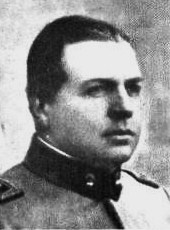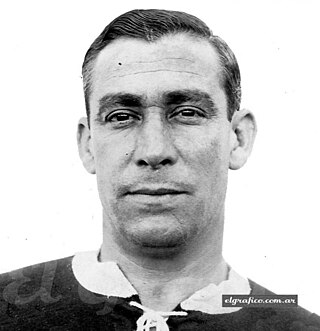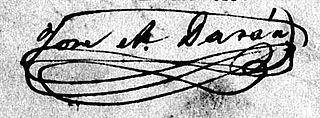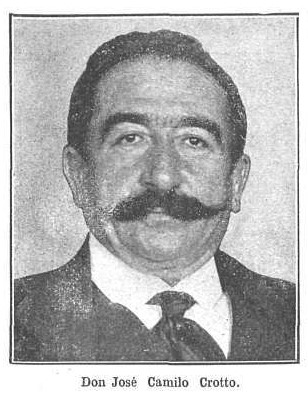
Enrique Carlos Alberto Mosconi was an Argentine military engineer, who is best known as the pioneer and organizer of petroleum exploration and extraction in Argentina.

The Central Entre Ríos Railway (CERR) was a railway company in the Entre Ríos Province of Argentina, owned by the provincial government, which built and operated a 1,435 mmstandard gauge railway network between the rivers Paraná and Uruguay. In 1892 it was sold to the British–owned Entre Ríos Railway.

Zoilo Canavery was an Uruguayan football player. Born in Montevideo, Canavery was a notable figure of Argentine sport during the 1910 and 1920 decades, playing in four of the "big five" of Argentina, such as Independiente, River Plate, Racing and Boca Juniors.

Angel Mateo Canavery was an Argentine military man, who participated in the Conquest of the Desert under the command of General Julio Argentino Roca. He also took part against the Montoneras of Ricardo López Jordán, and against Civic Union troops during the Revolution of the Park.

Juan de Canaveris was an Piedmontese lawyer and politician, who served during the viceroyalty of Río de la Plata as accounting officer in the Tribunal de Cuentas de Buenos Aires. He had achieved a high social status in the Viceroyalty of the Río de la Plata, where he supported the revolutionary movements of May, being the only neighbor of Italian origin who attended in the Open Cabildo, of May 22, 1810.

Manuel Canaveris was an Argentine army officer, who took part in the defense and reconquest of Buenos Aires during the English Invasions. He served under Colonel Ignacio Álvarez Thomas in the 4th Regiment of Buenos Aires, participating in the Campaigns to the Interior of the Provinces of 1810.
Juan José Canaveris (1780–1837) was an Argentine jurist and politician, who served as military man, lawyer, notary, prosecutor and accountant of Buenos Aires. In 1809 he was honored by the Junta Suprema de Sevilla, for his heroic participation in the defense of Buenos Aires, during the English invasions in the Río de la Plata.

Joaquín Canaveris was an Argentine attorney, merchant, politician and military man, who served as consignee in The Consulate of Buenos Aires. He had an active participation in the defense of Buenos Aires during the English invasions, serving as an Assistant in the battalion of Tercio de Vizcaínos.
Saturnino Canaveri was an Argentine military man and politician, who served as officer of the 2nd Cavalry Regiment. He took part in the main military actions that occurred during the Conquest of the Desert, including the actions prior to the Battle of Aluminé, against the Chilean Army.

Sinforoso Amoedo was an Argentine medical doctor. He served during the yellow fever epidemic of 1871.

Ferrocarril Económico Correntino was the informal name for some former narrow gauge State-owned railway lines in Corrientes Province of Argentina that used a gauge of 600 mm.
Ramón de Amaya was an Argentine-Uruguayan military man and politician, who fought against the English during the British invasions of the River Plate, and who participated in the Uruguayan Civil War.

Tomás Onésimo Canavery (1839–1913) was an Argentine Catholic priest and military chaplain, who served under the command of Bartolomé Mitre during the War of the Triple Alliance. He participated in most of the military actions against the Paraguayan forces, being promoted to lieutenant colonel in the same battlefield by order of General Juan Andrés Gelly y Obes.

Héctor Canavery was an Argentine politician and military man, who took part in the military campaigns in the territory of Patagonia. He also dabbled in politics, serving as a legislator for the National Autonomist Party.

José Antonio Durán was an Argentine military man and politician, who participated in the main military actions that occurred during the Argentine Civil War. He served as secretary of the Government of Nazario Benavídez, and as war correspondent of Juan Manuel de Rosas in San Juan Province.

José Camilo Crotto (1863–1936) was an Argentine politician, founder member of the Radical Civic Union. He served as national Senator and was Governor of Buenos Aires Province between 1918 and 1921.

Mariano Billinghurst (1810–1892) was an Argentine businessman and politician, pioneer in the construction of the national railroads. The locality of Billinghurst in the Great Buenos Aires, and a street (Billinghurst) in Buenos Aires City takes its name in his honor.
Bartolomé Saraví (1797–1862) was an Argentine army officer who toke part in the Argentine War of Independence. He served as General Minister of La Rioja Province, Argentina during the government of Vicente Mota in 1847.

Eloisa D'Herbil was a Spanish pianist and composer. A child prodigy on the piano, by age seven, she had played before the heads of state in England and Spain. As a child, the press dubbed her "Chopin in skirts" and from a young age, she began composing musical pieces. Immigrating to Argentina in 1868, she continued to write music, becoming one of the first women to write tangos.

José Francisco Ugarteche (1768-1834) was a Paraguayan jurist and politician, who had outstanding performance during the colonial and post colonial period of Argentina.


















